Selections:
Recorded: Greenland, MI, October 5, 1938; St. Louis, Michigan, August 22, 1938; Mt. Pleasant, Michigan, August 22, 1938
Performers: Gus Schaffer, Carl Lathrop, Bill McBride
Activity 1: Introduction to Lumberjack Ballads and Songs
- Teacher provides students with historic background to the lumberjacks.
- Michigan was part of the vast belt of virgin pine that once stretched from Maine and Nova Scotia west to British Columbia. From the mid-1800s through the early 1900s—when the forests were logged out—lumbering was one of Michigan’s chief occupations. For the last 30 years of the nineteenth century the state was the nation’s largest lumber producer.
- Wherever lumberjacks went they created songs that commented on their way of life. These songs traveled with them as they moved from one part of the country to another, following the pine forests. The names of rivers, camps, and other places changed as the lumberjacks changed locations.
- Lumberjacks sang many different kinds of songs—Civil War songs, Irish and English ballads, slavery songs, bawdy bar-room songs—but their songs about their own life and work are among the most important American occupational ballads (story songs about work).
- Michigan’s stately tracts of pine were a distant memory by the time Lomax arrived, eager to “record what remains of the once vigorous lumberjack culture.” He found many aging “shanty boys” [lumberjacks] who remembered ballads and songs from the lumbering heyday. The singers here were all old men by the time they recorded these songs, singing songs they had learned as young men decades earlier.
- This lesson explores three lumberjack songs and the fiddle tune “Leather Britches” as windows into the life of the lumberjack.
Activity 2: Musical Instruments of the Lumberjacks
- This rare photo of lumberjack musicians was taken in 1900 at Beneway Camp in northeast Lower Michigan. **Although the photo is taken out of doors, instruments would commonly be played inside the lumberjacks’ shanty or bunkhouse.
Q—What instruments to you see? [fiddle, bones, drum—note the “conductor” holding a branch as a baton!]
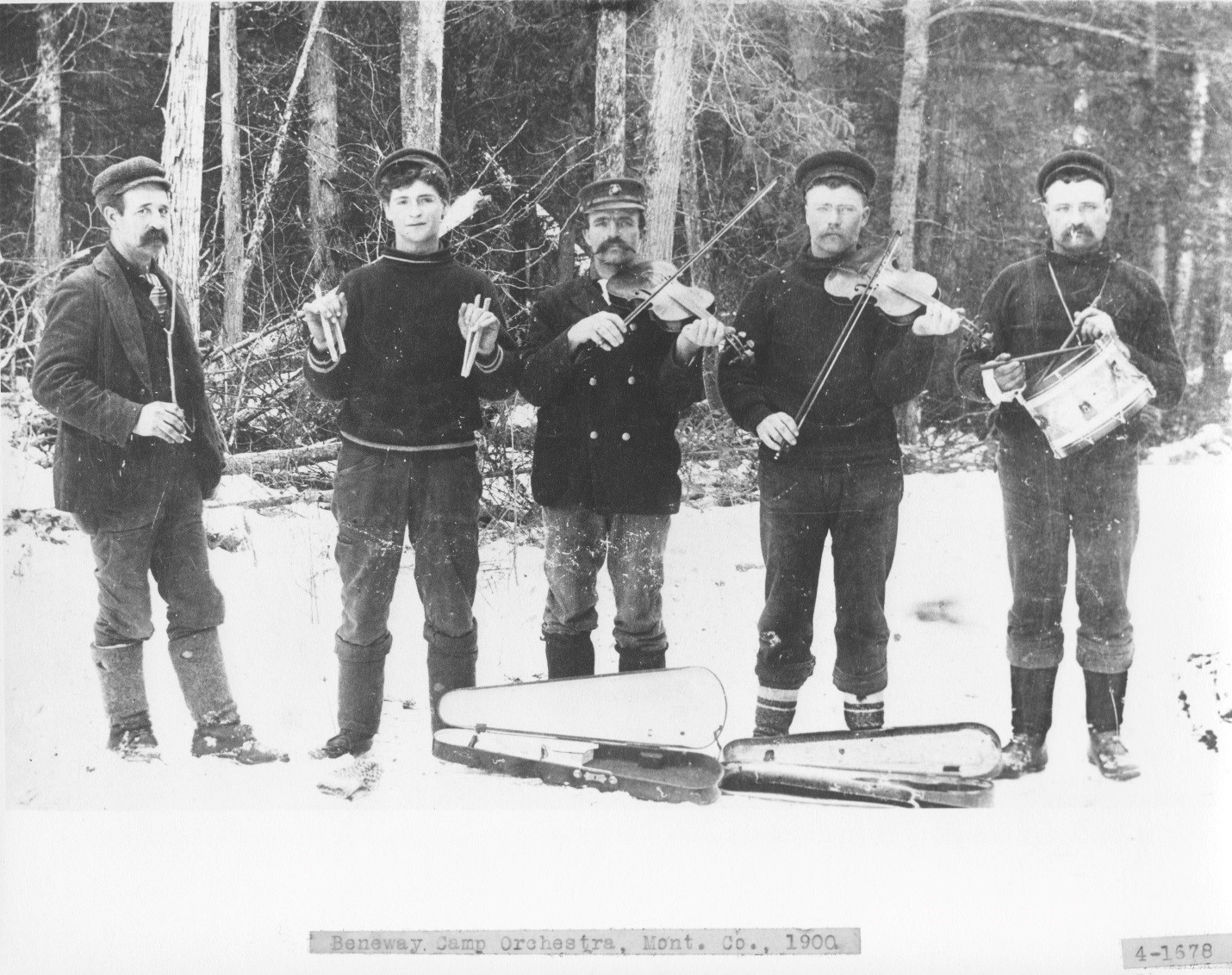
Photo of the Beneway Camp Orchestra, Montmorency County, MI, 1900. Courtesy of Alpena Public Library. Used with permission. - Students listen to the recording of “Leather Britches,” performed by former lumberjack Carl Lathrop and friends (likely fellow former lumberjacks Bill McBride and Perry Allen). This is a widespread fiddle tune in the U.S., of Scots and Irish origins. Lumberjacks would have danced to this tune. Since there were few women in lumber camps, men often danced solo jigs or together.
Q—What instruments do you hear? (fiddle and bones, also foot stomping) - Students create a bones rhythmic pattern with rhythm sticks. [*Note: the actual bones rhythm in “Leather Britches” is difficult to hear.] A possible pattern is shown below. Improvise other rhythms with body percussion or other percussion instruments.
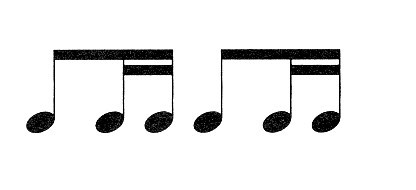
Activity 3: Contexts for Lumberjack Music Making
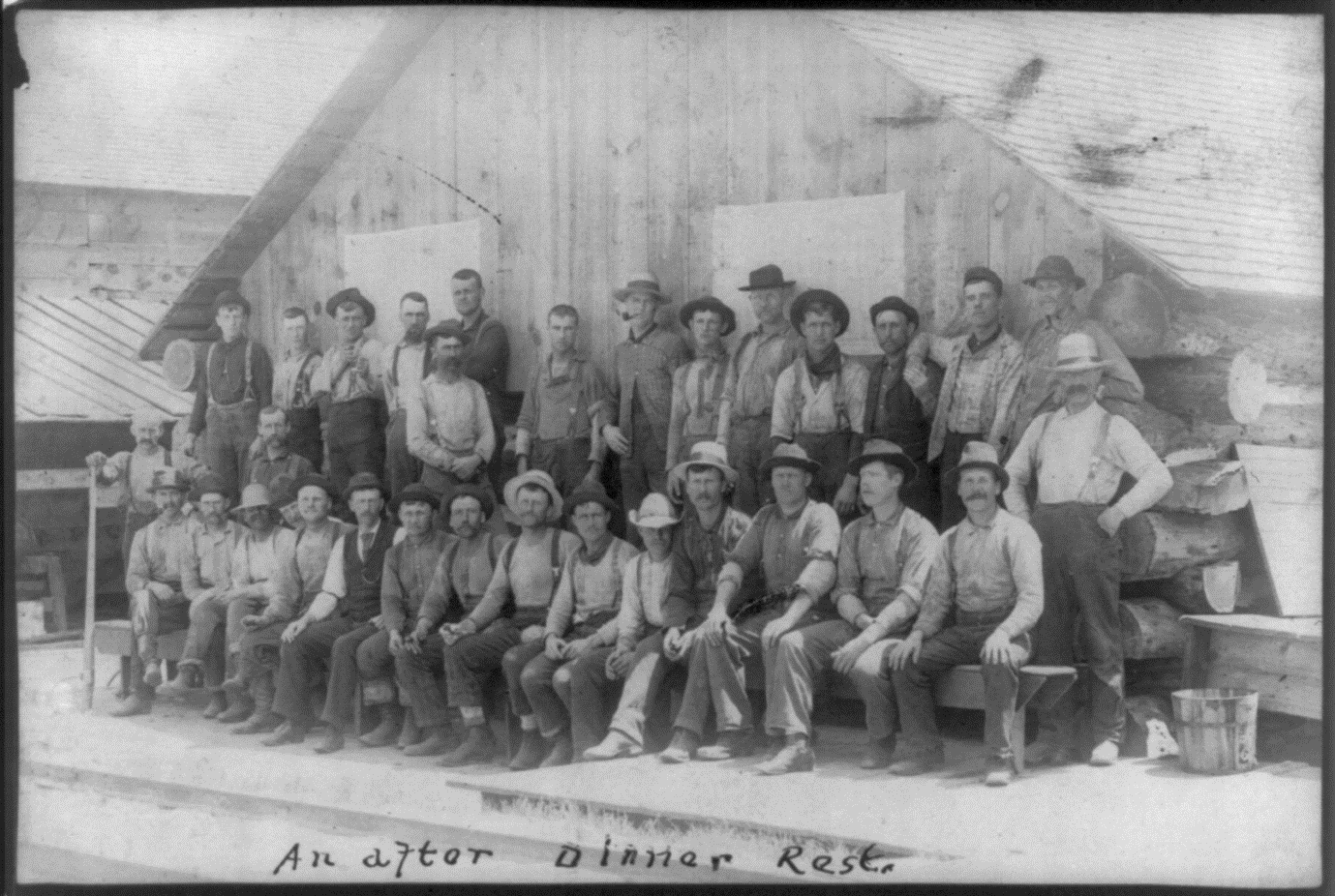
Q—Look at the photo of the lumber camp shanty above. When and where do you think lumberjacks were likely to sing and play music?
- Lumberjacks worked long hours, but on Sundays and between supper and bedtime the rest of the week, there was free time.
- Songs were learned and shared in the shanties or bunkhouses where the lumberjacks lived, on the decking grounds [area where stack of logs await loading], and at camps during log drives.
- Homegrown entertainment included stories, songs, stag dances [there were few women in the camps], card games, and music played on instruments like concertina, fiddle, hammer dulcimer, mandolin, guitar, and bones.
Activity 4: Alphabet Songs
**Note to teachers—this song refers to alcohol and chewing tobacco. Some teachers may prefer to teach the song using the alternate ending found below, and only listen to part of the recording.
“W is the woods we leave in the Spring,
And now I have sung all I’m going to sing.”
- Teacher explains that many occupational groups have alphabet songs that describe skills and tools of a particular job. No two versions are exactly alike.
- Students listen to the “Lumberjack’s Alphabet,” as sung by Gus Schaeffer, with or without the lyric sheet. Students may join along in the chorus, just as the lumberjacks did.
“Lumberjack’s Alphabet” by Gus Schaffer, Greenland, Michigan
A is for ax which we swing to and fro.
B is for boys that handles them so.
C is for *cant hooks, the logs we make spin. [tool used to lift and turn logs]
D is for danger that we’re always in.CHORUS
And so merry, so merry, so merry are we,
We are the boys when we’re out on a spree.
Sing Hi-derry col-derry, hi-derry-dum;
Give the lumberjacks whiskey and nothing goes wrong.E is for echo which through the woods ring, and
F is for foreman that pushes our gang.
G is for grindingstone, the axes we ground,
H is for handle that turns them around.CHORUS
I is for ink which our letters we’ve wrote, and
J is for jacket we wore for a coat.
K is for kindling, the fires we’d light,
L is for lice that bothers by night.CHORUS
M is for money, which everyone owes,
N is for needle that patches our clothes,
O is for oxen the road we swung through, and
P is for *Peerless, which everyone chews. [*popular brand of chewing tobacco]CHORUS
Q is for quiet, when we are asleep,
R is for rabbits which everyone eats,
S is for sleigh so stout and strong, and
T is for teams that tote them along.CHORUS
U is for use which we put ourselves to,
V is for valley, we tramp it right through,
W is for women when we’re down in the Spring,
And triple-X beer is the best beer to drink - Teacher provides period context for the song with historic photos. Students identify as many of the items mentioned in the song as they can. (Axe [front row, second from left], boys, cant hook [man standing on top of load of logs—a tool used to turn logs], handle, jacket, sleigh, team)
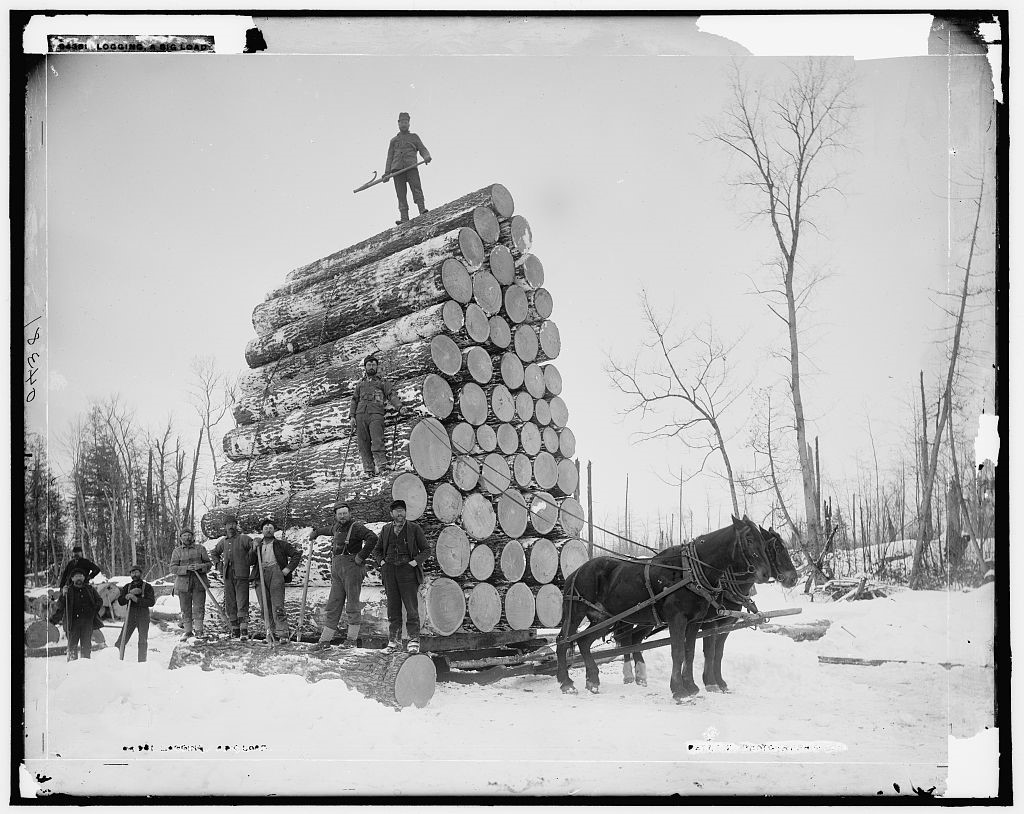
Lumberjacks with a big load. Photo from the Detroit Publishing Company Collection, Library of Congress. http://www.loc.gov/pictures/item/det1994003524/PP/ - Student’s write their own collaborative alphabet songs about a) being a student and characteristics of school; b) an occupation in your community or state (this could be expanded to a social studies research project); or another topic of your choosing. Use “Lumberjack’s Alphabet” as the structure for the new song, substituting your own community, neighborhood, school, etc. as the focus. Various occupations have specialized tools and terms that describe the work, such as cant hooks for lumbering. Brainstorm these same kinds of terms and tools for your selected topic.
Collaborative Songwriting Template (courtesy of Seth Bernard, Artistic Director of The Quest, Traverse City, Michigan)
Phase 1 Brainstorming and free association, ideally with a circle of 5 to 20 people. Participants each contribute a word or sentence that is then written down by the facilitator. After one round, everyone closes their eyes, and the facilitator recites the ideas of the group. Everyone listens to the sounds of the words and creates mental pictures of the words and phrases. Another round of brainstorming is shaped by the first round of words. Some words and phrases connect. Some may be another phrase that rhymes. [**With “Lumberjack’s Alphabet” or another pre-existing song as inspiration, you already have a melody to work with.] A large group may only have to go around twice.
Phase 2 Facilitator asks about connections of words and phrases. Consider using the existing rhyme scheme of AABB. Employ democracy and give everyone’s idea a chance, it works every time.
Phase 3 Work out verses, choruses, bridge, or riff. **With “Lumberjack’s Alphabet” existing music and melodic ideas can serve as a springboard for content. Or, simply use the entire tune.
Phase 4 Perform and record the song using a smart phone or a recording engineer. Do at least two takes of a song, creating a professional environment. Re-work the song as needed. Emphasize that everyone has a role.
Phase 5 Give a public community performance.
Activity 5: Lumberjack Ballads—Working Through the Seasons of the Year
- Teacher introduces ballads, or songs that tell a story.
- Many ballads start with a formulaic opening “Come all ye” just as this does.
- This lumberjack ballad sung by 80-year-old Carl Lathrop, a former lumberjack, describes the cycle of work throughout the seasons.
- Note: the first verse mentions two Michigan rivers where logging began in Michigan in the 1840s, the Saginaw, and one of its tributaries, the Tittabawassee.
- Students listen to the song, with or without the lyrics, paying attention to the different seasons of the year. Sing along with the chorus, just as the lumberjacks did. **Teacher may choose to introduce the concept of “rubato” during the singing of the chorus.
Q—What happens in winter? (cutting logs, transporting them by sleigh)
Q—What happens in spring? (log drive)
Q—What happens in summer (staying with girlfriends until logging season starts again)
Q—What tools are described (axe, cross-cut saw, cant hook)“Once More A-Lumbering Go” by Carl Lathrop, St. Louis, Michigan
Come all you sons of freedom, and listen to my theme
Come all you roving lumberjacks that run the Saginaw stream
We’ll cross the Tittabawassee where the mighty waters flow,
And we’ll roam the wild woods over and once more a-lumbering go.CHORUS: And once more a-lumbering go,
We will roam the wild woods over
And once more a-lumbering go.When the white frost hits the valley, and the snow conceals the woods,
The lumberjack has enough to do to find his family food.
No time he has for pleasure or to hunt the buck and doe,
He will roam the wild woods over and once more a-lumbering go.
CHORUS
With our cross-cut saw and axes we will make the woods resound.
And many a tall and stately tree will come crashing to the ground.
With cant-hooks on our shoulders to our boot tops deep in snow
We will roam the wild woods over and once more a-lumbering go.
CHORUS
You may talk about your farms, your houses and fine places,
But pity not the shanty boys while dashing on their sleigh,
For around the good campfire at night we’ll sing while wild winds blow,
And we’ll roam the wild woods over and once more a-lumbering go.
CHORUS
Then when navigation opens and the water runs so free,
We’ll drive our logs to Saginaw once more our girls to see,
They will all be there to welcome us and our hearts in rapture flow.
We will stay with them till summer, and once more a-lumbering go.
CHORUS
When our youthful days are ended and our stories are growing old,
We’ll take to us each man a wife and settle on the farm.
We’ll have enough to eat and drink, contented we will go,
We will tell our wives of our hard times, and no more a-lumbering go.
CHORUS“Once More A-Lumbering Go”
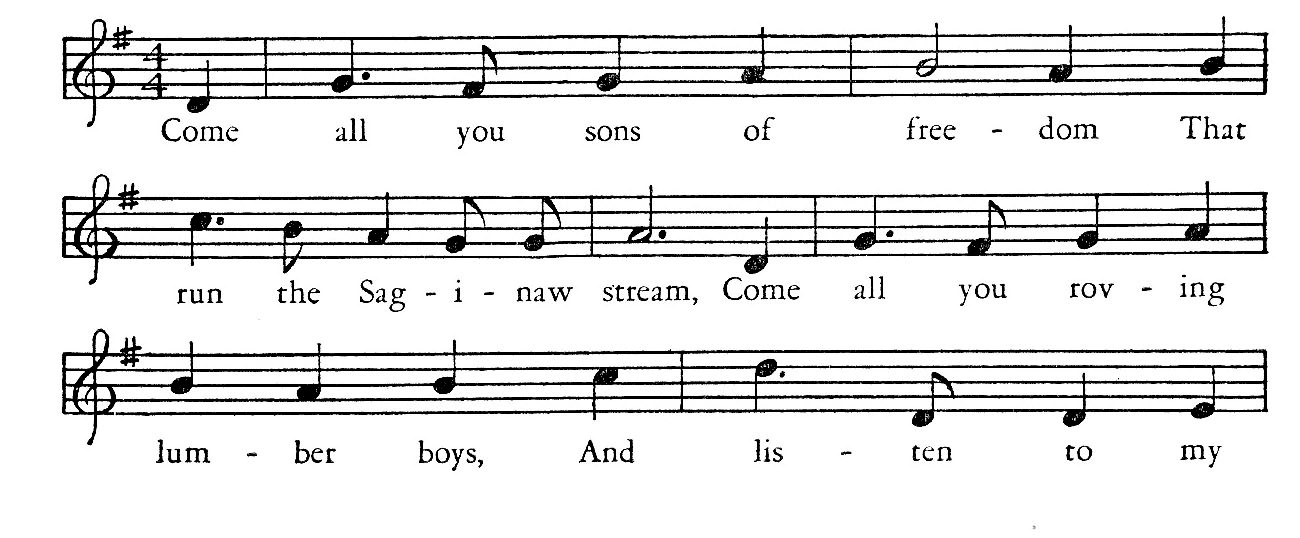
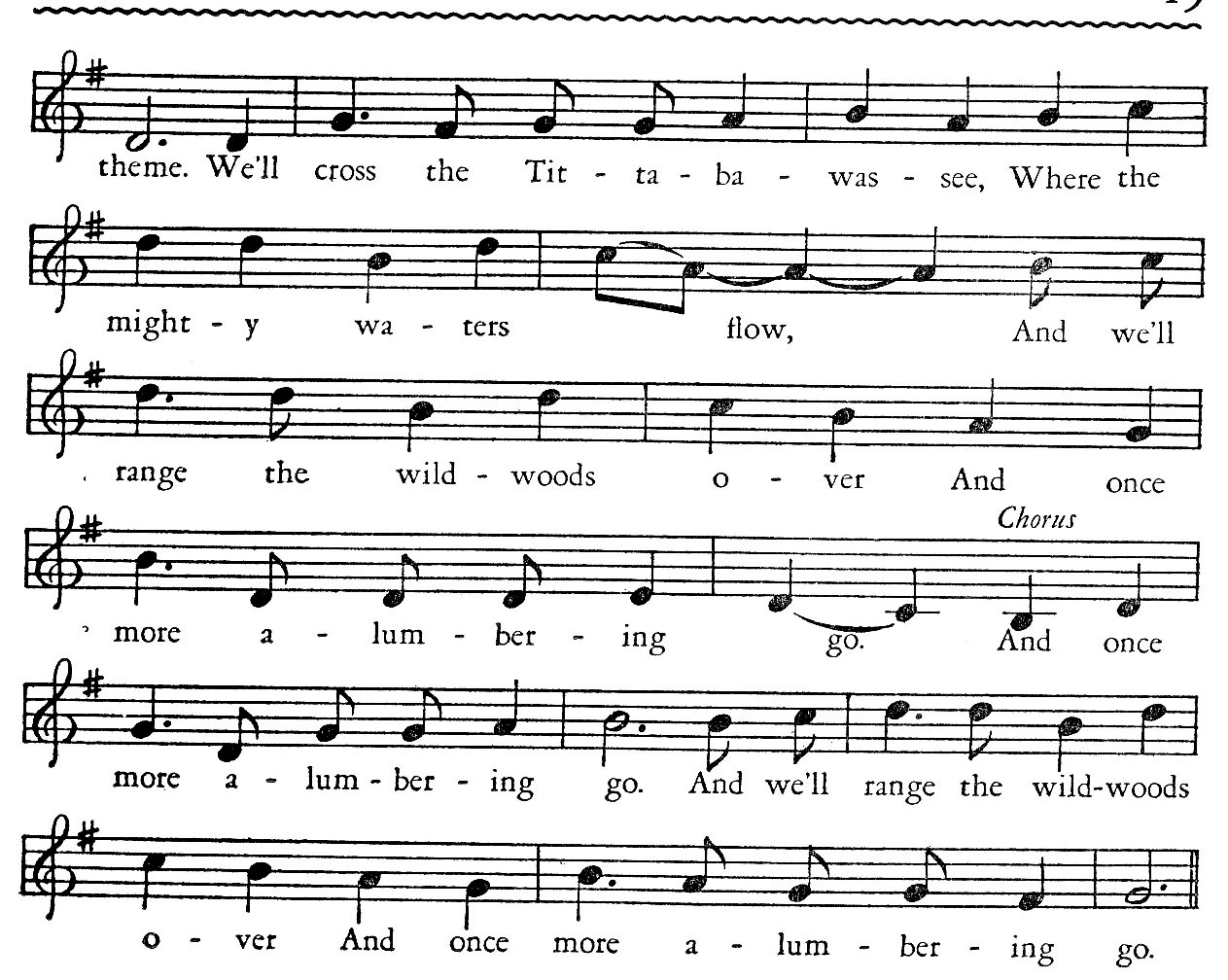
Version of “Once More A-Lumbering Go” with a tune similar to the Carl Lathrup version recorded by Lomax. This transcription comes from a version sung by Ferdinand McCrary of Hope, Michigan, as transcribed and published by Earl Clifton Beck in Songs of the Michigan Lumberjacks (1941). Used with permission. - Photo Scavenger Hunt
Students view the following period photos from the Detroit Publishing Collection at the Library of Congress. What parts of the text are illustrated in these images? [wintertime “when snow conceals the woods,” cross-cut saw, axes, boots deep in snow, trees on the ground, open navigation/log drive] **The long poles in both photos are called pike poles (not mentioned in the ballad text).
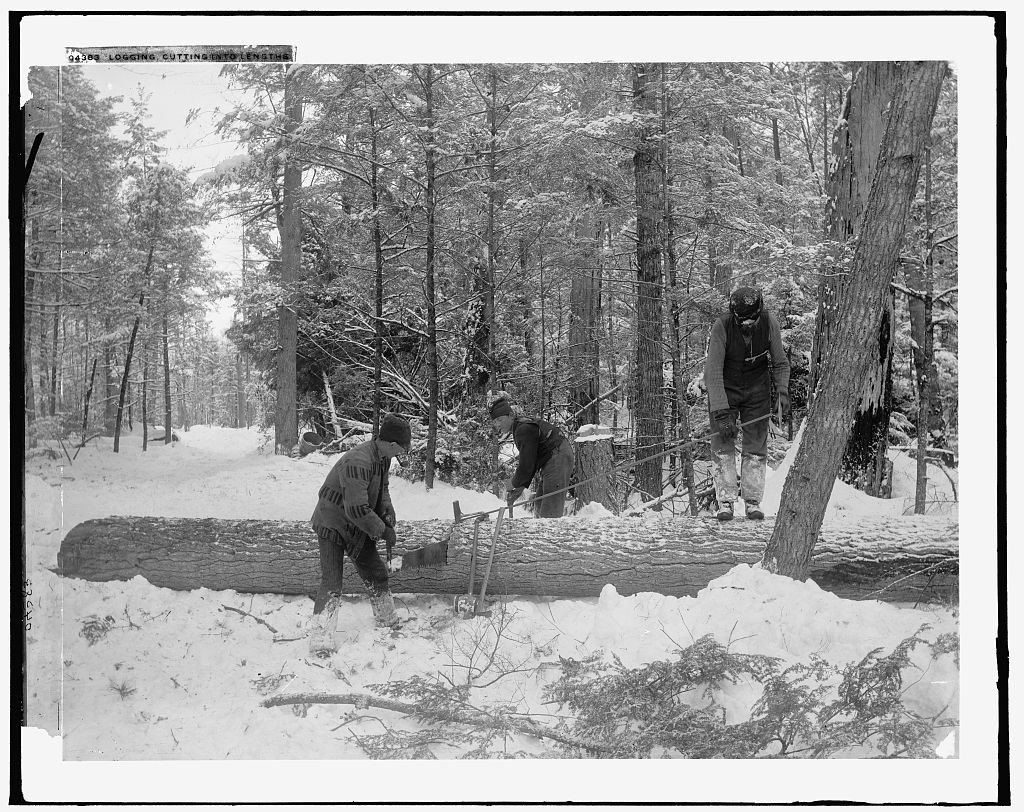
Lumberjacks cutting logs into lengths with a cross-cut saw. Photo from the Detroit Publishing Company Collection, Library of Congress. http://www.loc.gov/pictures/item/det1994003526/PP/ - Students write a ballad about the seasonal work of an occupation (for example, being a student, or an important occupation in your town or state). Note the AABB rhyme scheme. Modify the chorus to reflect the chosen topic, such as “We’ll roam the whole school over, and once more a-learning go.” Consider using the Collaborative Songwriting Template described previously.
Activity 6: Learn More about Lumberjack Life—“Johnny Carroll’s Camp”
- Students read and/or listen to “Johnny Carroll’s Camp,” another lumberjack ballad that gives good insight into the life and work of this occupation, including the camp cook and food.
- Teacher note: Emphasize again that ballads were valued primarily as stories and entertainment.
- A ballad singer like Bill McBride was popular among fellow lumberjacks more because of his ability to remember songs rather than the quality of his voice.
- Performer and co-composer Bill McBride had been a chopper, swamper, teamster, top-loader, and river hog for some of the biggest logging companies in the Great Lakes region.
- Michigan’s Chippewa River is a tributary of the Saginaw, once one of the nation’s best sources of white pine.
- McBride told Alan Lomax he and another lumberjack wrote this song around 1880.
- Teacher discusses the terms in the song that may be unfamiliar (a peavey, for example, is similar to a cant hook, but has a point on the end. Both tools are used for turning logs. The “grade” likely refers to a railroad grade or a road grade).
- Student groups brainstorm to write a new version of “Lumberjack’s Alphabet,” based on information provided in “Johnny Carroll’s Camp” and “Once More A-Lumbering Go.” The new song may be illustrated with drawings or historic photos.
“Johnny Carroll’s Camp” by Bill McBride, Mt. Pleasant, Michigan
(**Lomax erroneously calls this “’Johnnie Carleses' Lumber Camp”)One evening in November I happened for to stray,
To Johnny Carroll’s camp on the banks of the Chippewa.
With him I tried to grub and chop and level down the roads,
To make ready for our wintery snow through which our logs are towed.With grub hoes, pries, and axes we loosened the roots and stumps,
And we filed up all the hollows as we leveled down the lumps.
Now to be a perfect woodsman and to learn the lumbering trade,
You must spend a certain length of time a-toiling on the grade.Now choppers grind your axes and sawyers, file your saws,
And teamsters mend your harnesses, for these are lumbering laws.
The blacksmith and the tinker, they mend our tools so neat,
We dare not fear the work, brave boys, our tools they’re all complete.Our cooks they are good natured, we get the best of board,
We get the best variety our country can afford.
Potatoes, apples, turnips, beans and syrup, so pure and sweet,
Although we have no appetite we cannot help but eat.There’s bread and biscuits, pie and cookies, all seasoned to our taste,
And our cooks be very careful there is nothing goes to waste.
Our sleeping camp is well arranged with bunks long wide and deep,
And as night upon us reaches, boys, we quickly go to sleep.The chore boy in the morning gets up and starts the fires,
And keeps our camp so neat and clean we cannot but admire.
You’d ought to see us working as the weather is mild and fair,
With chains, cant hooks, peaveys, how we work the stately pine.From daylight until dark, brave boys, we toil day after day,
A-working in the pinewoods on the banks of the Chippewa.As winter ‘tis all over and our lumbering ‘tis all done,
We’ll go out on the river, boys, and there we’ll have some fun.
We’ll start our logs a-floating and we’ll drive them down the stream,
And before we’ll face for home, brave boys, we’ll sing the lumbering theme.
Extensions:
Research the work of contemporary loggers, especially if your school is in a logging area.
Explore other lumberjack songs and stories collected by Alan Lomax at Alan Lomax Collection of Michigan and Wisconsin Recordings. Search for performers Bill McBride, Perry Allen, Archie Stice, and Carl Lathrop.
Bill McBride and Perry Allen both told Paul Bunyan tales. Explore these and other tall tales about Paul Bunyan.
Credits:
Earl Clifton Beck’s Songs of the Michigan Lumberjacks (University of Michigan Press, 1942) provided information about lumberjack song and is still the best single source for this material.
E. C. Beck, ed., Songs of the Michigan Lumberjacks from the Archive of Folk Song, AFS L56, Recorded by Alan Lomax and Harry B. Welliver (Washington: Library of Congress, 1960).
Special thanks to Seth Bernard, Artistic Director of the Quest and source of the collaborative songwriting template, and to SEEDS of Traverse City, sponsor for the Quest Project. SEEDS is a 501(c)3 nonprofit organization established to foster local solutions to global issues.
For more information about the Quest collaborative songwriting project, see Laurie Kay Sommers and Samuel Seth Bernard’s article “Questing with Alan Lomax: Michigan’s Historic Field Recordings Inspire a New Generation,” Journal of Folklore and Education, Youth and Community, Vol. 2 (2015) http://locallearningnetwork.org/guest-artist/journal/.
Lesson Plan by Laurie Kay Sommers
With generous support from the NEA
